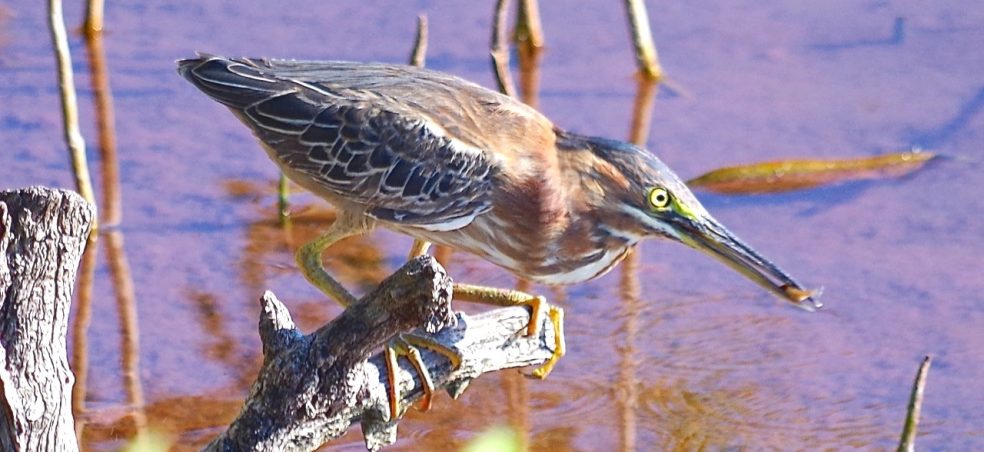SHORE THINGS: BEACHCOMBING ON A PRISTINE ABACO BEACH
The Abaco bay known as Rolling Harbour is a 3/4 mile curve of white sand beach, protected by an off-shore reef. The beach is pristine. Or it would be but for two factors. One is the seaweed that arrives when the wind is from the east – natural and biodegradable detritus. It provides food and camouflage for many species of shorebird – plover and sandpipers of all varieties from large to least. The second – far less easily dealt with – is the inevitable plastic junk washed up on every tide. This has to be collected up and ‘binned’, a never-ending cycle of plastic trash disposal. Except for the ATLAS V SPACE-ROCKET FAIRING found on the beach, that came from the Mars ‘Curiosity’ launch. 
We kept is as a… curiosity, until it was eventually removed by the men in black…
 I’d intended to have a ‘plastic beach trash’, Atlantic-gyre-rage rant, with angry / sad photos to match. Instead, I decided to illustrate a more positive side to beach life – things you may discover when you take a closer look at the sand under your feet. Like the coconut above. Many of these photos were taken by our friend Clare Latimer (to whom thanks for use permission); some by me.
I’d intended to have a ‘plastic beach trash’, Atlantic-gyre-rage rant, with angry / sad photos to match. Instead, I decided to illustrate a more positive side to beach life – things you may discover when you take a closer look at the sand under your feet. Like the coconut above. Many of these photos were taken by our friend Clare Latimer (to whom thanks for use permission); some by me.
 A LONE FLOWER
A LONE FLOWER SEA STAR (DEFUNCT), WITH CRAB TRACKS
SEA STAR (DEFUNCT), WITH CRAB TRACKS SEA FAN (GORGONIAN)
SEA FAN (GORGONIAN) WASHED-UP BOTTLE (PROBABLY NOT RUM)
WASHED-UP BOTTLE (PROBABLY NOT RUM)
Thanks to Capt Rick Guest, who has contributed an interesting comment regarding the sea biscuit with a hole in it. He writes “the (Meoma) Sea Biscuit w/ the hole in it was dined upon by a Helmet Conch. The Cassis madagascariensis, or C.tuberosa drills the hole w/ its conveyer-belt-like radula teeth w/ some help from its acidic, saliva. Probably 98% of all symetrical holes in marine invertebrates are of this nature. Murex, Naticas, Helmets, and many Cephalapods (via a Stylet), are the usual B&E suspects. The Cone shells utilize a modified radula in the form of a harpoon which is attached to a venom tube.” For more on the vicious cone shell, and other creatures to avoid, click HERE
DRIFTWOOD. IT’S LIKE… OH, USE YOUR IMAGINATION A WILSON’S PLOVER NEST
A WILSON’S PLOVER NEST HORSESHOE CRAB (LIMULUS)
HORSESHOE CRAB (LIMULUS) A SCULPTURE? AN EMBRYONIC SHELTER?
A SCULPTURE? AN EMBRYONIC SHELTER?  LARGE BIRD FOOTPRINTS
LARGE BIRD FOOTPRINTS MORE BIRD PRINTS AND CRAB TRACKS
MORE BIRD PRINTS AND CRAB TRACKS CRABUS CUTICUS
CRABUS CUTICUS CONCH SHELLS & OTHER BEACH TREASURES
CONCH SHELLS & OTHER BEACH TREASURES
 CRAB HOLE & TRACKS
CRAB HOLE & TRACKS SOME IDIOT’S LEFT HIS… OH! IT’S MINE
SOME IDIOT’S LEFT HIS… OH! IT’S MINE



Life’s a beach!
LikeLike
Well thanks for your nice photos, buddy. Esp. the horseshoe crab! x
LikeLike
I just loved your detailed shots – almost as good as beach-combing myself 🙂
LikeLike
Why thank you! I usually post my own photos, but not this time, so I will pass your comment on to the friend who took many of these. Thanks for calling in at Rolling Harbour. RH
LikeLike
Reblogged this on Beach Treasures and Treasure Beaches and commented:
What a wonderful way to start the week! Let’s grab our sunhats and go…
LikeLike
Hi Jody, thanks for spreading the sand around a bit! RH
LikeLike
My pleasure!
LikeLike
Hi RH! Most locals will know this,but the (Meoma) Sea Biscuit w/ the hole in it was dined upon by a Helmet Conch. The Cassis madagascariensis,or C.tuberosa drills the hole w/ its conveyer-belt-like radula teeth w/ some help from its acidic, saliva. Probably 98% of all symetrical holes in marine invertebrates are of this nature. Murex,Naticas,Helmets, and many Cephalapods(via a Stylet), are the usual B&E suspects. The Cone shells utilize a modified radula in the form of a harpoon which is attached to a venom tube. 99% of which feed on worms and other Molluscs. Only one species in the Western Atlantic/ Caribbean is known to be Piscivorous(fish-eating). This means it is also potentially deadly to humans. It is fairly rare in the Bahamas and even rarer to be seen out and about. It generally hides under the sand near reefs, but does emerge at night so as to consume slumbering fishies. I have seen one spear another fairly large snail known as a Music Volute. Best not to handle any Cone shells without gloves on!
LikeLike
Hi Rick. Thanks for the fascinating and rather gruesome information. I’ve mentioned some of this in sea shell posts – in particular the cone shells and their unpleasant proclivities… RH
LikeLike
I love it!! That sugar white sand is most inviting!
LikeLike
It is wonderful. Best paddled through just where the tideline reaches, where it’s hard and soft underfoot simultaneously. Then swim a bit!
LikeLike